How to Cross the Finish Line on Top
This year has been a significant one for my running journey. I recently surpassed a key benchmark at my gym’s “Catch Me If You Can” challenge by breaking the 4-mile barrier. I placed in the Top 3 at a trail half marathon in early October, and even hit a new personal best for my mile time, shaving it down to 4:38 — a record I’m incredibly proud of. Additionally, I’ve checked off three states from my goal of running a half marathon in every state, all in the same year I began this adventure with my very first half marathon.
With so many milestones, there’s not enough time to wax eloquent about each one or give them the full attention — the love and praise — that they deserve. Yet, I believe it’s worth diving into each of them separately, expounding on them. It’s better to capture these moments than to let them fade into a chasm of unrecorded memories. It’s like hiking to the top of a mountain and seeing a canyon — an abyss that stretches from peak to peak. No one wants to stare at a blank page where there should be words, emblazoned in dark ink. So, I’m determined to take the time to put these experiences into words that capture the essence of the memory, and hopefully, resonate with others.
Half Marathon in Connecticut
My first half marathon was on April 21st of this year, in Reston, VA; for those curious, I blogged about it too. I finished with a time of around 1 hour and 37 minutes, but the hills nearly got the best of me. I had prepared by doing trail runs, especially on the W&OD Trail nearby, though I’m not sure how much it helped with those relentless climbs. Before my first half, I carb-loaded with pasta – a tradition I’ve dutifully carried out and executed for every half marathon and most races since.
Heres a photo of me on my first half marathon and race – the same one I blogged about:
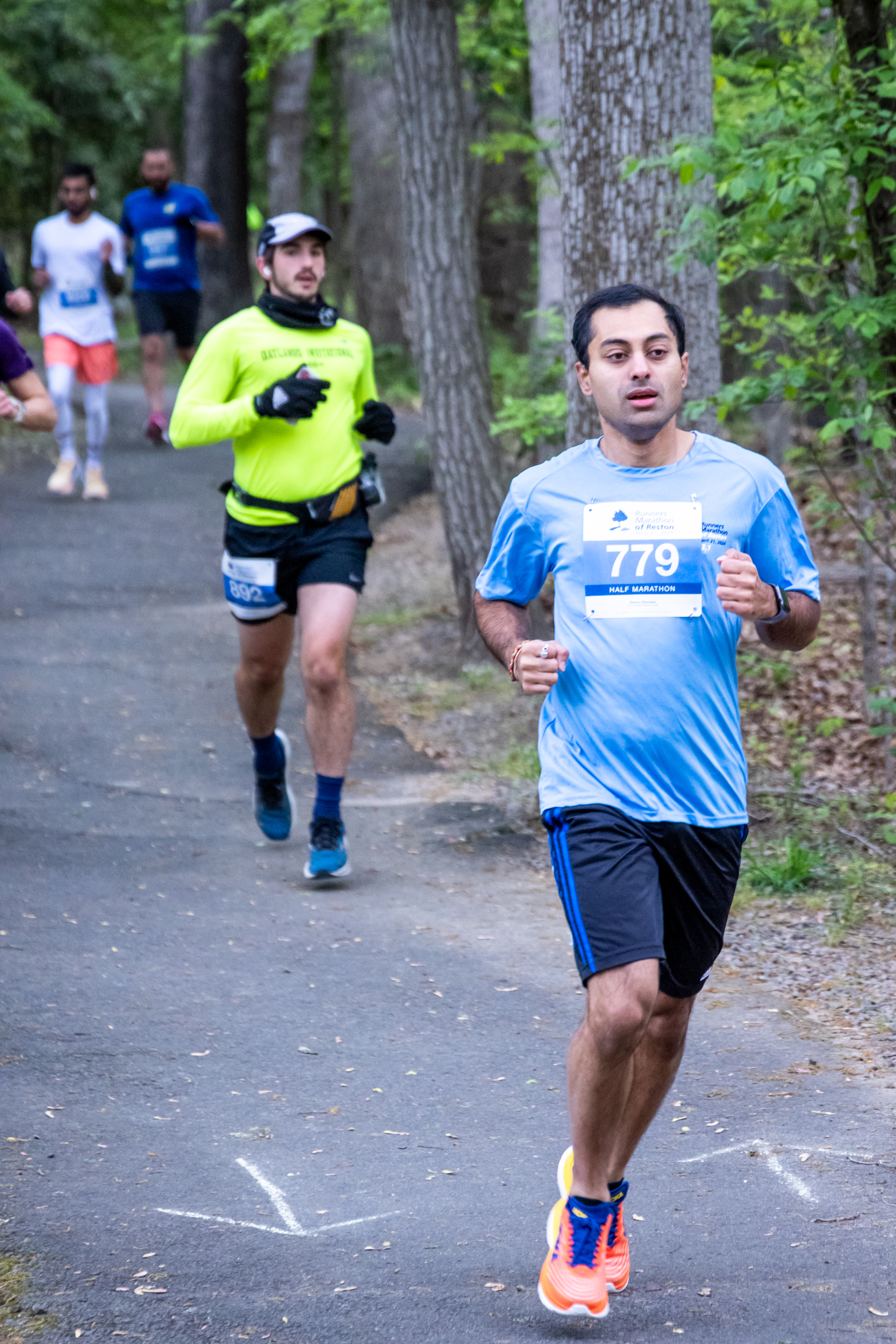
My first half taught me a lot about running the 13.1-mile distance, and about running in general. For example, running uphill is tough – borderline brutal – and has the potential to destroy me as a runner, while running downhill is exhilarating, a ride you should never fight. Don’t fight gravity. What goes up must come down; and the unfortunate converse holds true as well. It’s like an unspoken law of running, and of life itself. Newton should’ve taken note, if you ask me.
Another tip is on how to get water at the aid stations. I don’t know what’s the best thing, to get water at each aid station, or only to pick it up as needed. I guess it depends on certain conditions, like how hot and sunny it is on race day. The thing is, this being my first time, I didn’t know the best way to get water at aid stations. As a result, I spilled some on my shirt, unintentionally soaking it in liquid, or else almost choked as I tried to swallow water too fast. I’m still learning the art of drinking water as one is running. But I think I’m getting better on it.
One last thing, it’s about getting lost in races. This unfortunately is still a problem with me, and it’s more prevalent in races of longer distances, such as half marathons. The reason here is that it’s very, very hard to run next to someone the whole way of it.
In my first half, I must have gotten lost on the race course at least twice. I had to shout at least once at a volunteer on the sidelines, inquiring “which way (do I go)?”. They pointed out the right direction, otherwise for the life of me, I wouldn’t have known. Even at the finish line, I got confused and ran the wrong direction, cutting left instead of looping around right; I got corrected by someone, and I cursed but went the long way to the finish. The point is, getting lost wasted precious time – and had I seen at least one other runner near the latter end of it, that wouldn’t have happened to me.
For the first 10K at least, I ran next to someone. But that is unusual in a race of a longer distance, such as a half marathon. The point is, it’s hard to match someone’s pace, and run next to them the whole way. Harder yet to carry on a conversation, when you’re so focused on racing, and on finishing with a good time.
The half marathon is a truly challenging distance, for not just you but everyone else attempting that race and distance. It humbles you as a runner, similar to hill running or incline workouts on the treadmill. My first half had a lot of newcomers who did not understand the distance of a half marathon, or 13.1 miles. Their minds could not comprehend it. Mine could barely comprehend it too. I was not a complete newcomer, having run the half marathon distance at least twice in a practice trail run. Still, it somehow managed to humble me once again. I have to attribute this to the sheer number of hills as well as the hard to run sections, in my first half marathon.
That said, I carried some of these lessons learned about racing and half marathon running, into my 2nd half marathon, which transpired in New London, Connecticut.
I had signed up a long time earlier for that previously, like maybe around May or so. Not sure exactly when. The CT race was posted in the group chat on one of my running groups. It was free at the time to sign up. For the first 100 people to sign up, or so. I hastily jumped on that bandwagon and signed up for the free half as soon as I could.
I posted a while ago about my new car that I bought as a birthday gift for myself, in July. A Red Tesla, Model 3. I got 3 months of Free Supercharging once I picked up the car out of factory. Well, at the start of August, I decided to put those Free Supercharging Miles to use, and put the pedal to the metal.
As the fuel cost for the trip was free anyway, my family decided to join me on the trip, because why not. I went to my parent’s home and I picked them up, and also our dog, a lab mix. Packing and getting ready took a long time, as there was a lot of luggage, including a bed for our dog, and putting everything in the car took a lot of effort and time – including using all available space such as the frunk, trunk, cabin interior, foot space, and even the glovebox I believe. I also made sure to get some must-have accessories for my new Tesla, such as all-weather floor mats and a handy wired charging hub for phones and other devices, so I was pretty well prepared. Anyway once we got loaded, we took off.
So the trip time to our Airbnb in New Haven, CT was estimated around 6 hours or 350 miles, if memory serves correct, but in reality with supercharging stops and breaks along the way, it took closer to 8 hours. I also had an included FSD (Full Self Driving) subscription that was expiring exactly a month after I got it, so it was a great time to put it to use — especially because I enjoy driving so much, and rarely would use FSD otherwise. I drove almost the entire way to CT, just myself (and FSD to alternate between). I learned a lot about road tripping and long-distance driving with a Tesla on my first road trip with my Tesla. For example, do you know how uncomfortable the driver’s seat gets after the first hour? Mad uncomfortable, and shooting back pain starts after an hour or two. Trust me, I just found about this the hard way. Also, I learned a lot about optimal supercharging for road tripping, and also how to use FSD for road tripping. It really helped in certain cases, like at the start when there was just so much traffic, back to back traffic. No one wants to drive in those cases. It’s stressful. So that’s where FSD really shines — it handles all this perfectly, including slowing down when needed, such as when a frustrated driver switches abruptly to your lane. Even otherwise, after driving 3-4 hours straight, one gets a little tired. I would get tired after driving for an hour or two, my nerves a bit frayed and my brain a bit exhausted and hurting from seeing and navigating nothing but the road, and that’s when I switched to FSD with the press of a button. Essentially handing over the reins to another driver — a non-human one! Harnessing the power of AI, I was able to use FSD as a “co-pilot” of sorts, and relegate the necessity and task of driving to it. I am glad to say, it performed extraordinary well! Only in certain edge cases on the eternal highway, such as roads converging and diverging especially nearing the toll booths, or construction areas, did I (or the driver) need to wrest control and take over the reins abruptly from Supervised FSD! And yes, there’s a reason they call it “Supervised” FSD instead of Full Self Driving. Anyway, I did not drive on the whole way. My dad also drove partway to and from Connecticut, and also pretty frequently in the meantime we were in Connecticut. It was his first time driving an EV, especially as my parents own fully gas-powered cars. We arrived at our Airbnb in New Haven, CT at around midnight on Friday or close to it, and we unpacked the necessary luggage and hit the bed almost immediately.
I’ll add on more to this section as time allows. We had two Airbnb’s in Connecticut, one in New Haven and another in Middletown. Supercharging was a bit difficult at times, as Tesla Superchargers were not in some areas in CT. In Middletown, it rained almost every day, at around the time of year we went, which was depressing. A good thing as we mostly used our Airbnb spot to bunk down for the night, and drove or traveled extensively otherwise.
The evening before my race, we ate out at an authentic Italian restaurant – Consiglio’s – that served pastas.
I left a review for the spot, on Google and Yelp (below).
Read Ritvik N.’s review of Consiglio’s Restaurant on Yelp
The 62nd annual Ocean Beach/John & Jessie Kelley Half Marathon took place on Saturday, August 3rd, in Ocean Beach Park, located in New London, CT. I think we left around 6 AM from our place in New Haven, as it took close an hour to get there. I chose to wear my bright orange Hoka shoes for it.
There was quite a bit of hill running involved in the race, but not as many as in my first half, thankfully. Most of the run was on flat ground, usually on the road. One would think that would enable me to move faster, however, it’s worth pointing out the race took place at the peak of summer, in August.
It was pretty hot and humid outside, but not so much – maybe 60s to high 70s if I had to guess. What was worse that after about an hour or so, it got pretty sunny, and the blistering heat started to get to me. It got to the point there were dedicated volunteers along the sidelines of the route standing with hoses with those attached sprinkler heads, who would spray down anyone who got close enough to the sides. I saw a lot of other runners do this, and I myself willingly got my head, neck, shoulders, and parts of my shirt sprayed down.
They were handing out both water and gatorade at the aid stations, and I drank each indisciminately. At the latter half of the race, they were handing out entire plastic water bottles at the aid stations. Initially, I would drink a bit from the bottle, jog with it, and then drink a bit more to replenish my lost fluids; it helped, but I realized this was somewhat inefficient, because the added weight of the bottle and the liquid (water) inside slowed me down in a sense.
At one of those aid stations, I was too exhausted and I had to walk it out for at least half a minute; this happened to me at least twice more. I believe the reason was that I had started out too fast, likely closer to my true 10K pace – around 6:30/mile – which I maintained for at least 7 miles, but after that point I started to break down from sheer exhaustation, general lack of endurance, fatigue, and dehydration.
I saw others grabbing the full water bottles at the aid stations, drinking one or two gulps, dumping the rest on their head, and then immediately tossing it away; seeing wisdom in this, I followed suit and did the same.
Never have I been more glad to see something, when I saw the finish line in my sights. My lungs were killing me, and one final kick – my last-ditch effort – enabled me keep toe to toe with another runner who had crept up from behind me, and we both finished at almost the same time.
Here’s a (shirtless) photo of me after the race. It was a hot day, and most other race finishers were getting sprayed down by what looked like a grand hose with a showerhead, so I decided to partake as well.
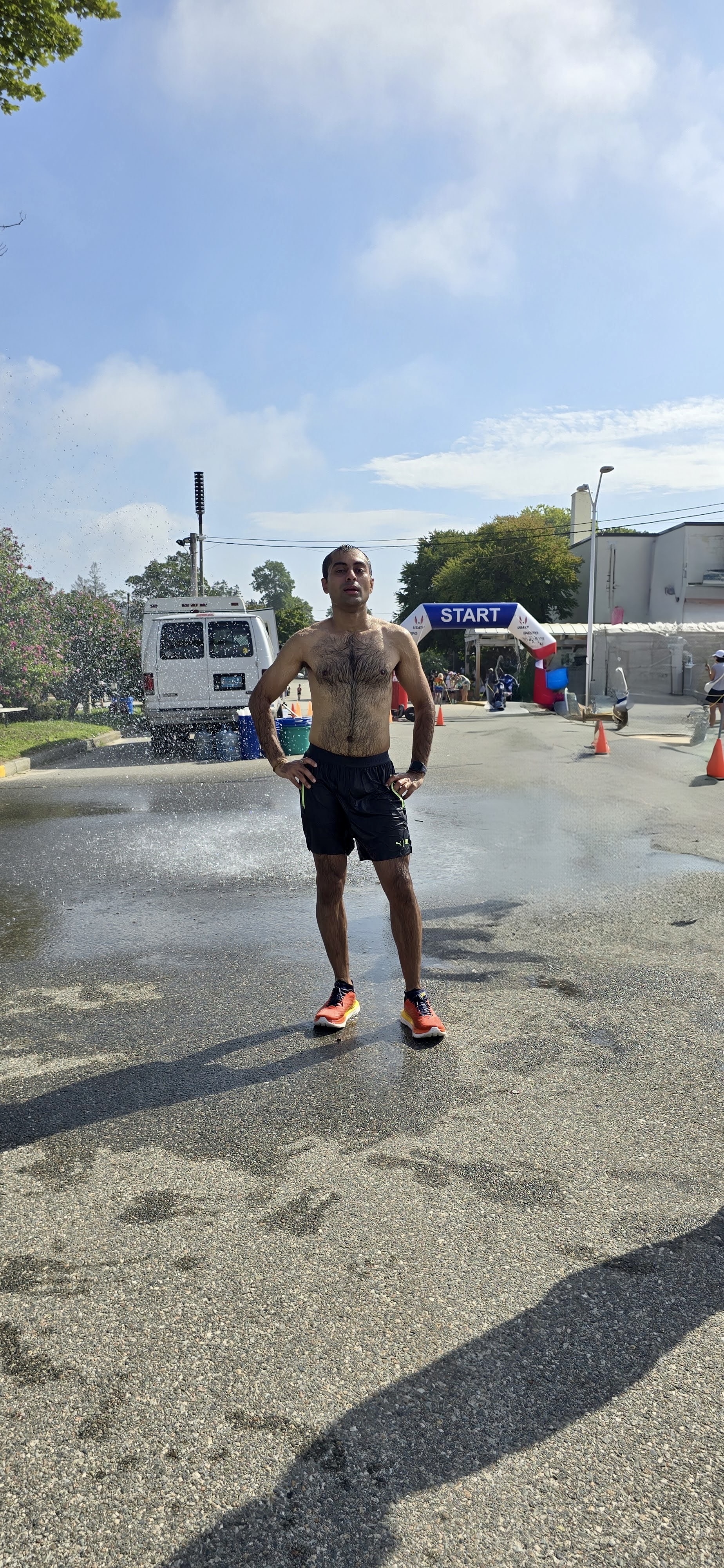
I’ll add more details to this race, but it went well, and I got a new PR and finished in a little under 1 hour and 32 minutes. It took a lot out of me, and I stopped and rested or walked at least 3 times because I was too exhausted to run. Still, I am glad and proud of the PR and enjoyed the experience overall.
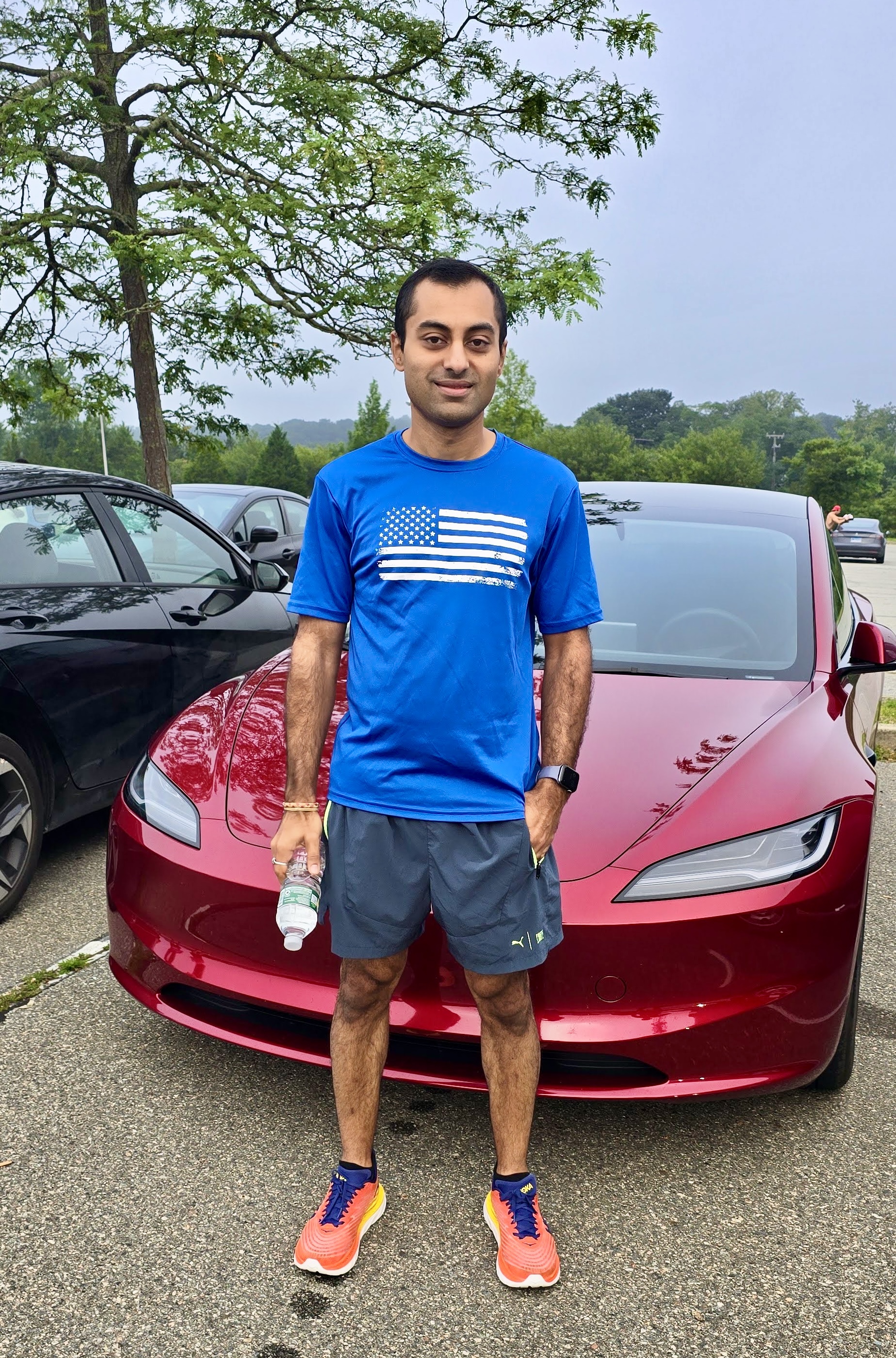
Me After The Race
Afterwards, my sister joined us via a flight, and then alongside her, our family continued exploring Connecticut and nearby areas in our road trip. We visited Mystic, Old Saybrook, the Yale Campus and Wooster Street in New Haven, Hartford which is the Capitol of CT, other spots around Connecticut, and even drove up to Rhode Island and visited Newport, RI; also we separately drove up to Massachussets and visited a lot of beaches — especially dog-friendly beaches —and places there such as Provincetown, MA.
Overall, the road trip was a huge success and we enjoyed sightseeing Connecticut and places we had not been to before.
12 Minute RFD
I also got a PR on the 12-minute Run for Distance while in New Haven, CT and I forgot to post an update on this but will do so when time allows.
Catch Me If You Can
Google AI is now as strong as ever. In fact, AI itself is now as strong as ever.

I just asked Google, “when was last cmiyc” and here is what it responded with:
The last Catch Me If You Can (CMIYC) workout at Orangetheory Fitness (OTF) was on August 22, 2024. The next CMIYC is expected to take place around January 24, 2025, based on an average of 155 days between each CMIYC.
The CMIYC is a race against the clock workout at OTF. To avoid getting caught, you need to run at an average of 8.4 miles per hour for the entire 20-minute workout.
That’s pretty good, and mostly accurate. The only correction I’d add is that CMIYC is actually a 22 minute long treadmill run, not a 20-minute long workout. Of course, that is presuming that one runs an average of 8.4 MPH as mentioned, and achieves 2.8 miles at minute 20 — 8.4 MPH * 20 minutes / 60 minutes/hour. Given that condition’s satisfied, one gets an extra 2 minutes to rack up distance on the treadmill. All in all, it’s a pretty fun benchmark challenge. It’s actually my favorite challenge at OrangeTheory, all said and done.
Given that the last time I did CMIYC was a couple months ago, in August — it’s October now that I’m writing this down — there’s a lot that I’ve forgotten about when I attempted it. I guess that’s the curse with not writing about a challenge or a personal achievement, immediately after doing or attempting it. Still, I will attempt to hearken back and remember what transpired.
CMIYC which was near the end of August, a month that was designated as “marathon month” by the gym I go to. What is Marathon Month? Well, it’s a month where you challenge yourself against other members at OrangeTheory, by racking up distance on the treadmill. You can sign up to complete various distances throughout the timeframe of a month, such as a half-marathon, a marathon (26.2 miles) and even an ultra marathon which is 50+ miles. This was my first time attempting Marathon Month and I signed up for the Ultra, of course, since I enjoy running. I started preparing for CMIYC alongside racking up miles in MM, by basically taking at least one 2G class a day, and also signing up for as many Tread 50 classes as my legs could handle, and challenging myself to run the whole 45-minute block. The speed or pace didn’t matter as much a the fact that I could maintain a pace the entire block, without walking it out. At the end, I got about 120 miles for Marathon Month, and got 1st place at my gym.
The day before CMIYC, I did a prep or warm-up run as I usually do the day before a challenge. I went 0.2-0.3 mph below my goal or target speed for about 70% of the benchmark duration, which for me was about 10.9 mph for about 14-15 minutes. I trained at my usual 2% so that I can be ready for 1% which is what the challenge requires. Once I achieved that, I knew I was ready for the challenge the next day, or as ready as I could hope to be.
I believe I went in for CMIYC at lunch break, at around noon. Nutritionally, I prepared well with a well-rounded breakfast of oatmeal and berries, and made sure I was loaded up on caffeine. I alternated between 11 and 11.2 mph, that is 11.2 mph for a minute every 3rd minute and fall back to 11 mph for “recovery” — if memory serves correct — and I ended up with 4.08 miles down after 22 long minutes, and claimed first place on my gym’s leaderboard and ranking for the challenge. Super proud of that achievement!
Here is a candid, post-run photo of me:
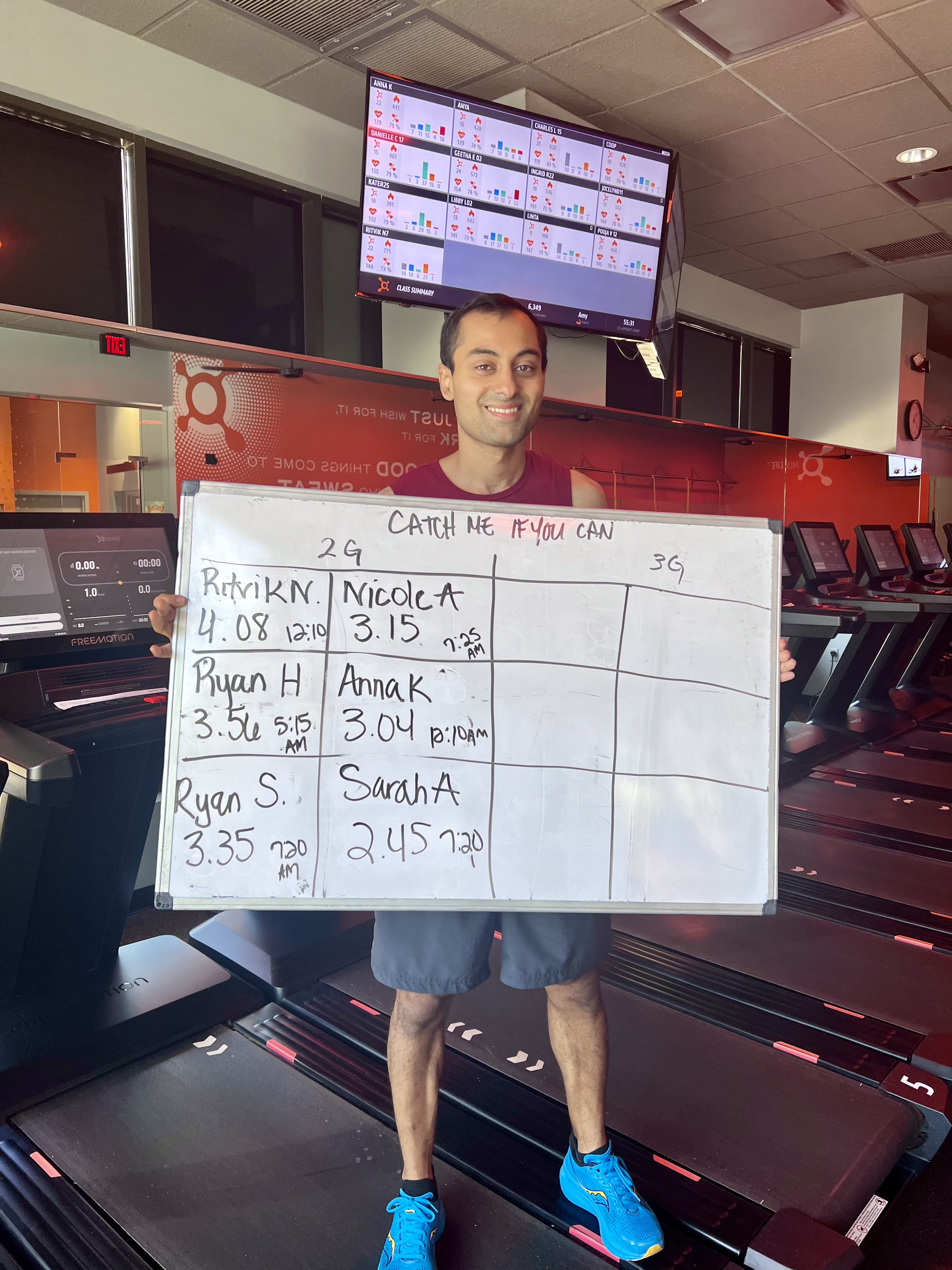
Afterwards I was basking in the glory of having broken the personal barrier of 4 miles for the CMIYC distance, because that is something I had only dreamed of achieving, and thus fancied it as a pipe dream. The last time I had attempted to break 4 miles in CMIYC, I suffered a persistent knee injury, as I blogged about, which prevented me from running for about a week. Thus, I was understandably nervous and anxious about attempting it again this time around. Still, super proud and excited to have finally achieved my goal of breaking 4 miles on CMIYC! 🎉
Dri Tri
Oh yeah that reminds me, Dri Tri (Dry Triathlon) is another benchmark challenge at OrangeTheory, and I forgot to blog or post about that!
I got a PR, likely a lifetime PR, of 32-something minutes — 32:43 which easily beats my previous PR of 36-something minutes.
My secret likely was in good nutrition and planning, including signing up for the later time of 10:30am or so, which gave me necessary time to fuel and prepare, as well for my body to digest what I’d consumed.
Still, right shoes was also key! I wore my favorite running shoes for these types of benchmarks, and that also enabled me to run under a 17 minutes for the 5K distance!
Also, moving a bit faster on the rower and especially floor blocks /w the body weights really helped me.
Here’s me with my Dri-Tri completion certificate, some time after completing it and taking a shower and setting aside some much-needed recovery time:
Half Marathon in West Virginia
As fate would have it, my three months of complimentary Tesla supercharging was destined to expire exactly three months after I rolled my new ride off the factory floor. The date? October 6th — a Sunday that loomed like a sunset, signaling the end of my “on the house” road tripping experience. Knowing the juice was worth the squeeze, I set out to make the most of those dwindling days of cost-free power. With a home charger quietly humming along, I hadn’t needed — or really felt the urge — to visit a supercharger for a while. But this time, I decided to stretch that muscle, milk those last drops, and wring every bit of value from this fleeting perk that would soon vanish into thin air.
As the calendar flipped to October, I took my search to the digital highway — hopping between Google and race websites, scouting for half marathons in states near my humble abode in Virginia. My shortlist included nearby adventures in Maryland, Pennsylvania, West Virginia, Ohio, Tennessee, and South Carolina—places where the drive was manageable, ideally less than 10 hours behind the wheel, with landscapes that would etch a memory for my first race in a new state.
After narrowing down my options to two or three promising contenders, I turned to ChatGPT for a nudge. The Pirate Half in Tennessee caught my eye, though it came with a catch — an extra 200 miles of road compared to a race I found in West Virginia. And the allure of a free bike hiking tour made it even more tempting, promising a scenic escape. Even yet, the Strasburg Half in Pennsylvania beckoned with the convenience of proximity, a mere three-hour drive away. With all the races falling on the same weekend, I found myself in a tug-of-war between options, hoping for a little guidance.
I posed my dilemma to ChatGPT like so:
Deciding between NEW RIVER GORGE WILDS TRAIL RUN and a few other half marathon races this weekend on Oct 5th. Pirate Half in Knoxville, TN, was one, and Strasburg Half in PA was another. Which will be best for me to sign up for?
The advantage of a digital companion with a memory? ChatGPT already understood my mission—running a half marathon in every state—and it knew I was searching for an event that would leave an indelible mark, with a course as breathtaking as the journey itself.
ChatGPT’s response, albeit exhaustive, cut right to the heart of my quandary:
Given your goals of enjoying breathtaking views during runs and your endurance background, I’d recommend the New River Gorge Wilds Trail Run if you’re up for a challenge and want a scenic adventure. However, if you’re looking to focus on speed or prefer a less intense race, the Pirate Half Marathon in Knoxville would be a better fit for this weekend.
With that, my path became clear. I shelled out $70 for a spot in the half marathon distance at the New River Gorge Wilds Trail Run, knowing that while it was the highest price tier, it was a small price to pay for an experience I wouldn’t soon forget. In the back of my mind, I felt that $70 was a steal for the registration—even though I’d waited until the week of the race and had to pay the highest price tier. After all, I usually see half marathons going for double that, even for “early bird” pricing, which frankly can feel overpriced. I missed out on a free race T-shirt by registering so late—an oversight that stung a little, but a lesson learned all the same.
| Pricing Tiers | Price |
|---|---|
| Early Bird - Ends June 30th | $50.00 |
| Advance - Ends October 2nd | $60.00 |
| Day of Race | $70.00 |
What is the New River Gorge Wilds Trail Run, exactly? Here is a blurb on the race from their website:
The New River Gorge Wilds Trail Run is the newest running event at ACE Adventure Resort this Fall. Runners can choose to participate in a full marathon, half marathon or a 5k run. Cash prizes will be awarded to overall top finishers and over $1,000 in prizes and awards are up for grabs! Runner perks include free camping Friday and Saturday nights, finisher medals, race shirt, and burrito buffet after the run. Run wild with us through the gorgeous fall colors this October 5th.
So, they mentioned they offered free camping at the Resort on Friday and Saturday evening. I’ll get to that shortly. They also have a burrito buffet post-race, which caught at my eye, as it seemed like it would be sorely needed in my case.
As outlined on their race website, they had 3 events that started at the same day and time:
- Full Marathon
- Half Marathon
- 5K
All said and done, that is the story of how I eagerly signed up for the New River Gorge Wilds Trail Run for the Half Marathon — 13.1 mile — distance. I also let my family know about this via our group chat, shared with them the details as well as the impetus behind it — free supercharging ending on race weekend — and made known my plan to camp at the Resort, in an effort to save on accommodation.
Now, I haven’t camped in a really long while — feels like a decade or more at this point — and I did not have any camping gear on hand, and really had no idea what I was doing. I figured I needed to grab a tent from somewhere like Costco or Walmart, and then order the other necessities from an online storefront like Amazon, or else borrow one from my family.
However, for better or worse (probably for the best) this “camping” plan that was admittedly riddled with holes got shot down, before it had a chance to become fully realized and come to fruition. I got convinced by my fam — actually my Mom, who’s more level-headed and sensible than me — to consider alternate accommodation nearby, one that did not involve camping, which I was sorely ill-prepared for.
I looked out and considered few options such as AirBnb, but the cheapest actually was lodging such as a hotel or motel. I booked a stay for a single night at Skyline Lodge in Ghent, WV — which was a little less than an hour from the location in Oak Hill, WV where the race was set to take place, ACE Adventure Resort.
Some time after, I got word on the wire that my Dad would be joining me on my trip to WVA. So it was decided, and that Friday, we left around lunch break, and alternated driving to our lodging in Ghent, WV. The drive from Northern Virginia to the stay in West Virginia was incredibly scenic, and overall a great experience.
We arrived in the evening right around sunset, with dinnertime right around the corner. After searching for nearby Italian and pasta spots, I chanced upon Pasquale’s in Beckley, WV.
I event left a review for it:
Read Ritvik N.’s review of Pasquale’s Italian Restaurant on Yelp
The food was excellent, likely the best Italian food I’ve eaten in my life of 30+ years.
<TODO add more here when time allows>
My race took place on Saturday, October 5th, 2024, at Ace Adventure Resort in Oak Hill, West Virginia.
The drive there went OK for the most part, and then once we hit the horrendous dirt, gravel, and rock-strewn roads at ACE Adventure Resort, it started to wear down on me, because I could only go below 10 MPH, and 15 MPH tops. It was a jerky ride, and the drive was too bouncy, and not enjoyable at all.
Anyway, I stood in line and picked up my race bib, and clipped it on my attire all by myself – a first for me.
The race was supposed to start at 9 AM on the dot. In reality, we started after a half hour delay, because some guy was explaining everything to all of us, and some folks were late to register and sign up. Also, it was hard to coordinate a large crowd of around 200 runners, who were signed up for three different events or distances – the marathon, half marathon, and the 5K Run.
Funny guy, at a little after 9 AM, when the race should have started, he initially said: “OK everyone, COME ON let’s line up already, race starts in 10 seconds! Here we go, 3… 2… 1!” I could swear my heart skipped a beat, but then he immediately corrected myself: “Just kidding, I’ll give you guys a break, let’s start at 9:30 AM.”
Attire-wise, I decided to go sleeveless this time, wore my go-to race shorts with no pockets, Feetures moisture-wicking quarter socks, and my bright orange Hoka shoes.
Me in all my glory, with pre-race nerves intact:
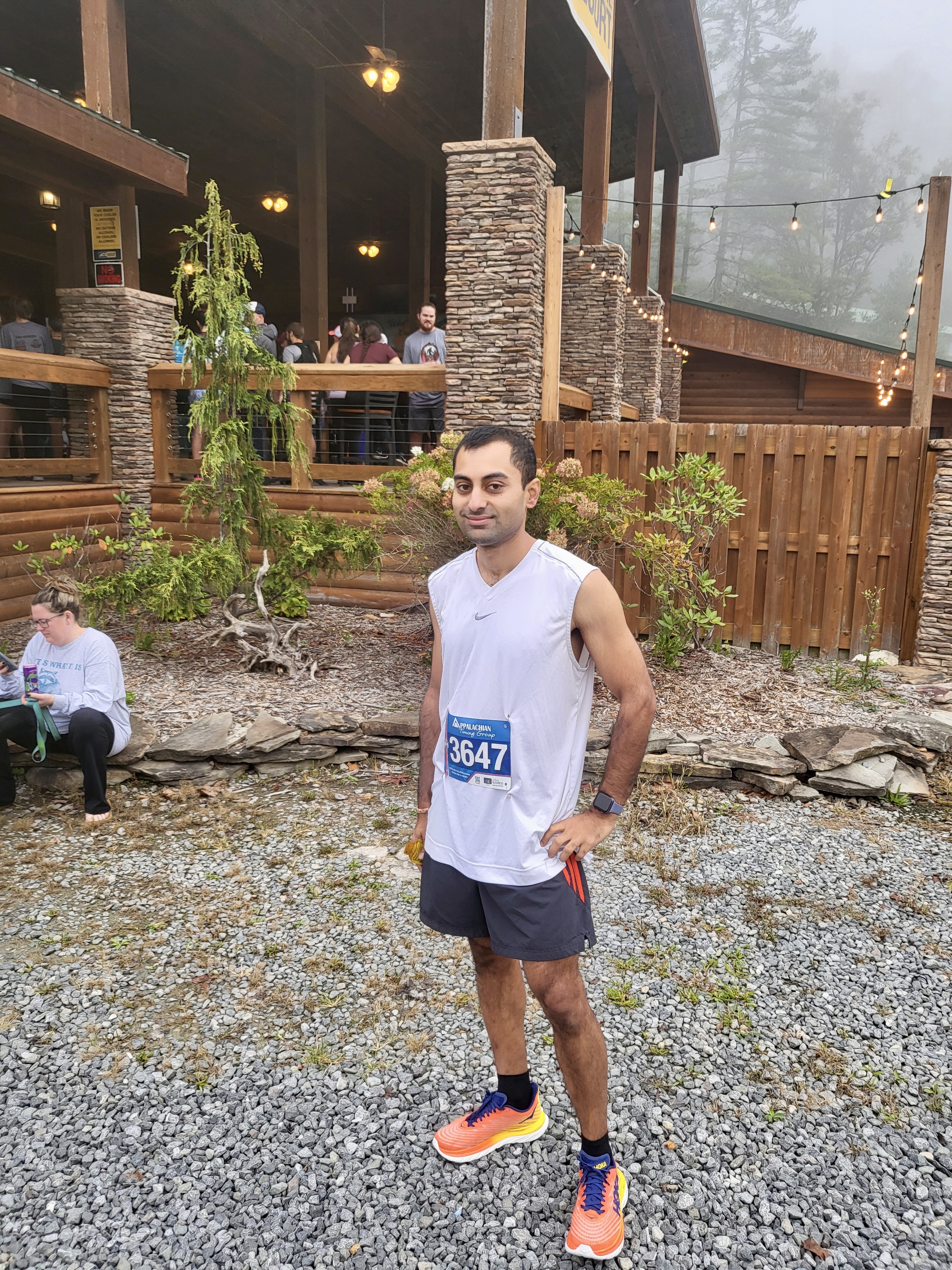
I drank electrolytes before, skipped my tea so I was almost running on empty when it came to caffeine, but thankfully I possessed the faculty and good sense to carry an (organic) energy gel – Honey Stinger – with me.
Anyway, here’s the race map:
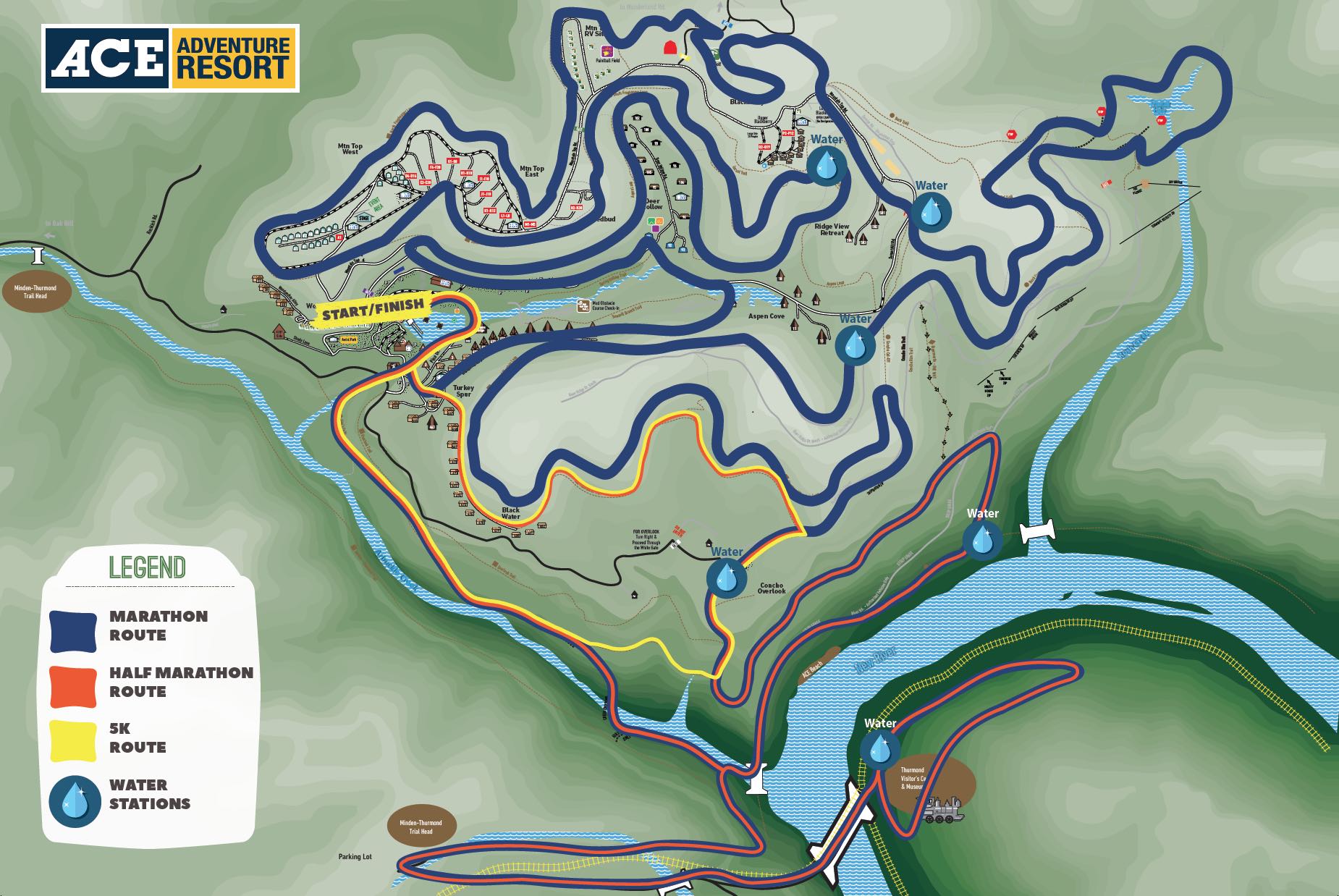
As you can see, the half marathon and marathon runners share the same path, for the large bulk of it, roughly about 10 miles or so. At roughly around the point they split up, the 5K runners join up with us — the half marathon runners. In reality, none of us actually saw any of the 5K runners join up with us near the end, because it was at least an hour or so since the start by that time, and very few 5K runners take more than hour to run the 5K (3.1 mile) distance. The route is an out-and-back for parts of it, but it appears to diverge in the second half of it, and head back on a different route altogether.
It was a true trail run, and it took a lot out of me. I had actually not examined the race map too closely — truthfully not at all — and also I had never run a race on the trail before, so I really did not know what to expect. If I could describe it now after experiencing it firsthand, I would say the trail run as a whole was brutal and challenging, and the half marathon distance is the limit of how long I can run that.
I took the energy gel at around the halfway point. I am grateful I carried it with me, because I sorely needed it to keep me going.
All said and done, I finished the race in 3rd place, with a time of 1:50:03. In reality, I crossed the finish line in a little under 1 hour and 50 minutes, as can be seen below.
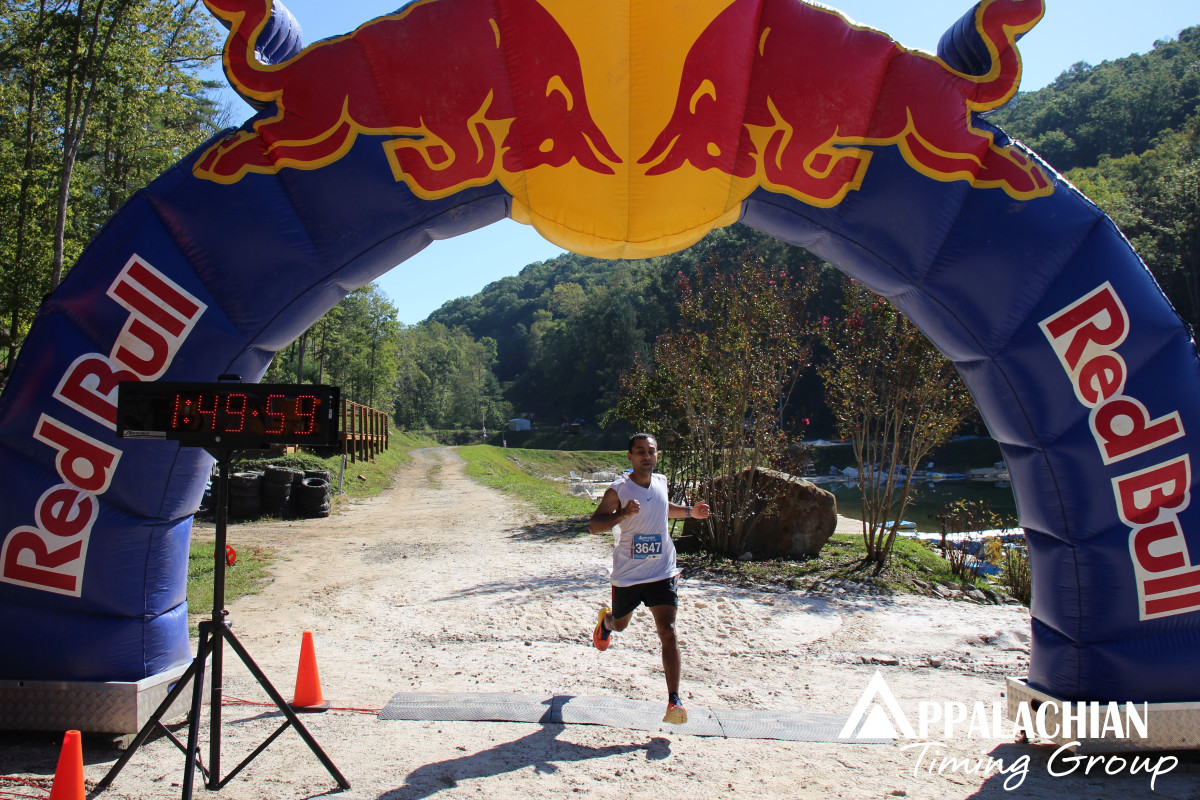
I placed Top 3 and 3rd overall in the race, and 3rd in my gender group. Here’s my race certificate in case others are curious.
Pictures didn’t do it justice, but here is the vista and view of the finish line for that race. It was a beautiful day, and in hindsight, the run itself was scenic and awe-inspiring, as promised. West Virginia lives up to its moniker of “Wild Wonderful”, for sure! So many hidden gems and trails like these, it is mind-boggling to even think about.
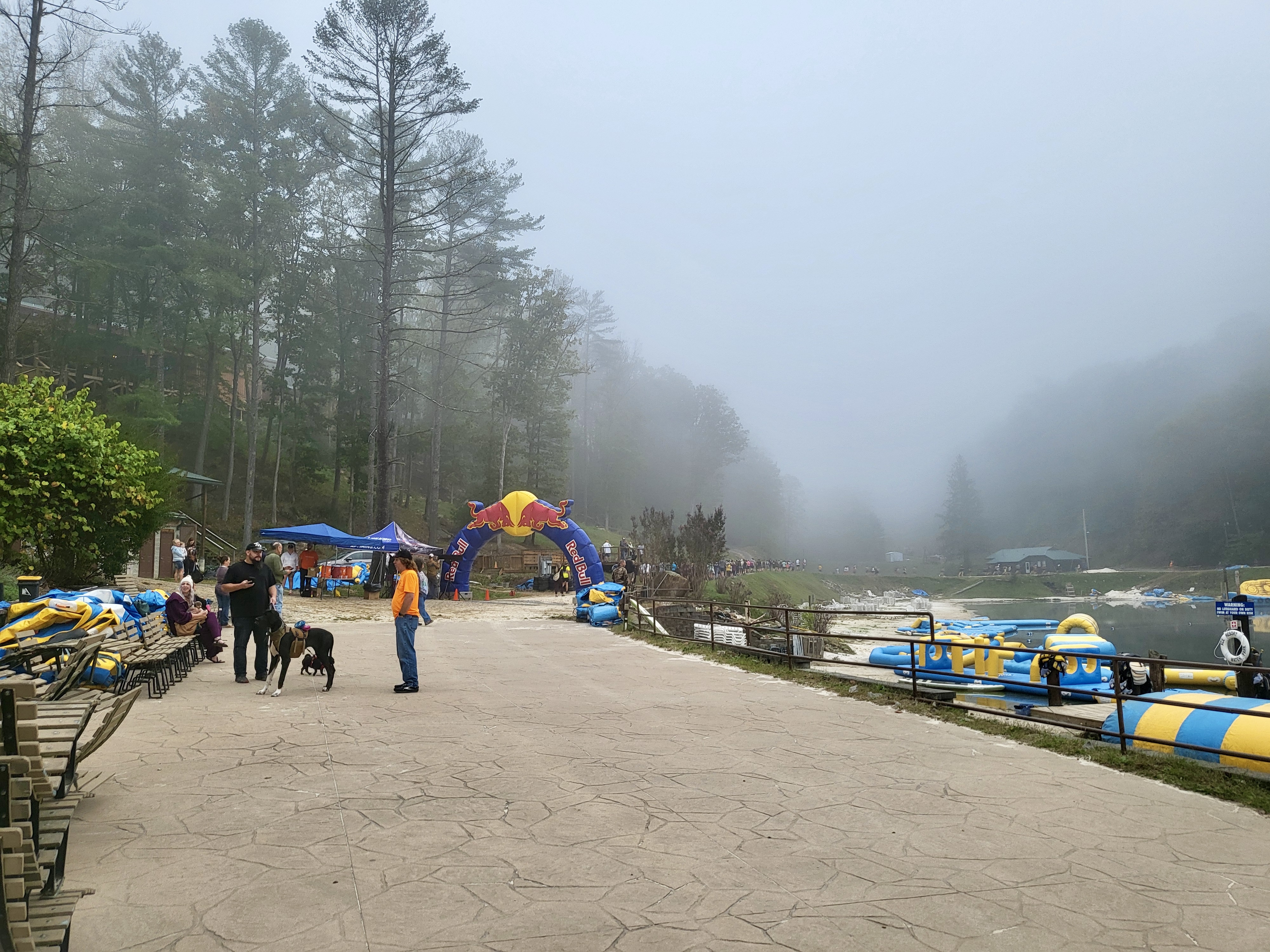
Going to add on to this when time allows, but in summary I am glad that I checked off West Virginia from my list of states to run a half marathon in. Now, only 47 left to go!
1 Mile Run
On Wednesday, October 16th, OrangeTheory had the 1 Mile benchmark challenge that recurs every so often, and I grudgingly participated in it.
The last time around, I was on vacation around the Seattle, WA area, and at the gym I did it at, the treadmills only went up to 12 MPH, so I went at 1.5% and got an exact 5:00 mile readout.
Knowing how exhausting it can be to run a sub-5 mile, let alone a 5:00 mile, I was understandably apprehensive about it.
The weeks and then days leading up to it, the nervousness and fear about the ever-looming 1 Mile Run slowly built up, and got under my skin bit by bit.
The self-doubt was ever-present:
- Did I possess the same (or better) endurance? I was not getting younger, and I know age affects this in some important, not yet understood way.
- What if willpower wasn’t enough? Last time, I relied on force of will to overpower and drown out the loud, persistent voice in the back of my head telling me to give up the ghost and “Call it quits, Jim!” – but what if will or drive wasn’t enough this time around? What if this elusive mental resilience and strength, deserted me when I needed it the most?
I had a new pair of running shoes I’d bought for racing —- actually for my upcoming half marathons and races – from this app called StockX. I bid on it and though I could have got it for less, I still got under fair market value or at least what Nike was listing it on sale for at the time, just a cool $250 or so. In short, I played it smart and got it for less. The running shoes in question are the Nike Vaporfly NEXT %3 – AKA the Vaporfly 3 – the same line or family of carbon-plated shoes worn by many famous athletes and especially pro-marathoners such as Eliud Kipchoge, the only human to break the 2-hour barrier on the marathon distance.
The day before, I decided to break in my brand spanking new running shoes, by donning them alongside my new favorite moisture-wicking no-show tab socks from Feetures, and ran at 70% duration (and slightly reduced intensity) in a regular 2G workout. For me, that was 2% with at least 12.5 mph — adjusted, I was targeting around 12.7-12.8 mph for this pre-race effort — for at least 3 minutes and 15 seconds. Based on my performance stats from the app, I started at 12.9 mph, scaled down to 12.7 rather quickly, and pulled back yet again to 12.5 mph after 2 minutes or so, which I sustained for the remaining effort. In summary, I ran at an average of ~12.8 mph — adjusted for 1% — for about 70% of the anticipated race duration. I found that the new shoes were bouncy, springy, and helped me propel me forward and exerted less stress on my body and lungs, than my favorite (non- carbon-plated) pair of running shoes. All said and done, the Nike Vaporfly’s got a solid check mark from me.
Going to add on this as time allows, but in short:
- On race day, I prepared with good nutrition and used ChatGPT as a helper to chart out my diet and nutrition plan for the day. To clarify, I provided all the things I wanted to eat or drink or consume (in supplement form) on race day, and used ChatGPT as a sort of “scheduling assistant” to determine the ideal window or timeframe to take each of them.
- For instance, I air-fryed and ate 2 medium-sized beets drizzled in olive oil and pepper and salt and spices, 1-2 hours before the race.
- I took electrolytes via a Nuun Sport tablet, tart cherry juice, and caffeine — a cup of matcha — shortly before the race.
- I consumed fruits pre-race. I note the variety, quantity, and timing all seems to matter.
- I wore a loose-fitting and performance-enhancing attire and shoes, such as sleeveless, short with no pockets, moisture-wicking and blister-preventing Feetures socks, and of course my brand new pair of Nike Vaporfly Next%3 running shoes, the shining, resplendent and “front and center” stars in my PR attempt for the 1 Mile distance.
- I showed up early and chose my favorite treadmill to run on.
- I started at 13.0 mph at 1%, held for about three minutes, then pulled back to 12.7 mph when I started dying inside and could feel my legs starting to going numb like Jello – I could barely feel them. I tried multiple times to pump it up to 13 - 13.2 mph, but my body and legs were too exhausted, my brain was screaming at me, and it was a no-go. I tried to sustain at least 13.5 mph for the last 30-second “empty the tank” effort, and I mostly succeeded in that. At the end, my lungs were screaming for release, but more grateful by far were my legs, who had curiously gone almost completely numb from the prolonged intensity and speed necessitated by my ruthless, unyielding effort.
- I ended up with a finish time of 4:38 for the 1 Mile distance, though I wouldn’t have known the exact seconds were it not for our ever-watchful coach, who had their eye on the readout and stated it aloud. The upshot, I claimed first place on my studio’s leaderboard, and PR’ed by 9 whole seconds.
- I realized that I was able to maintain a mile at the same pace, roughly, as Eliud Kipchoge’s marathon pace — that is, the same speed and intensity he’s able to maintain for 26.2 miles, or at least 25x longer than all I could (barely) sustain it for. This fact is truly humbling, and puts things in perspective for me.
- I felt like I was barely holding it together for the first half, and terrible during the latter half of the the 1 Mile Run. More than once during that effort, I questioned my existence and even why I was attempting this. I felt much better afterwards, especially after social media praise and nods from others.
In closing, here’s a snapshot capturing my mix of exhaustion and exhilaration after hitting a new personal best of 4:38 for the 1-Mile distance—proudly displayed on my studio’s leaderboard and showcased here on my personal blog for all to see:
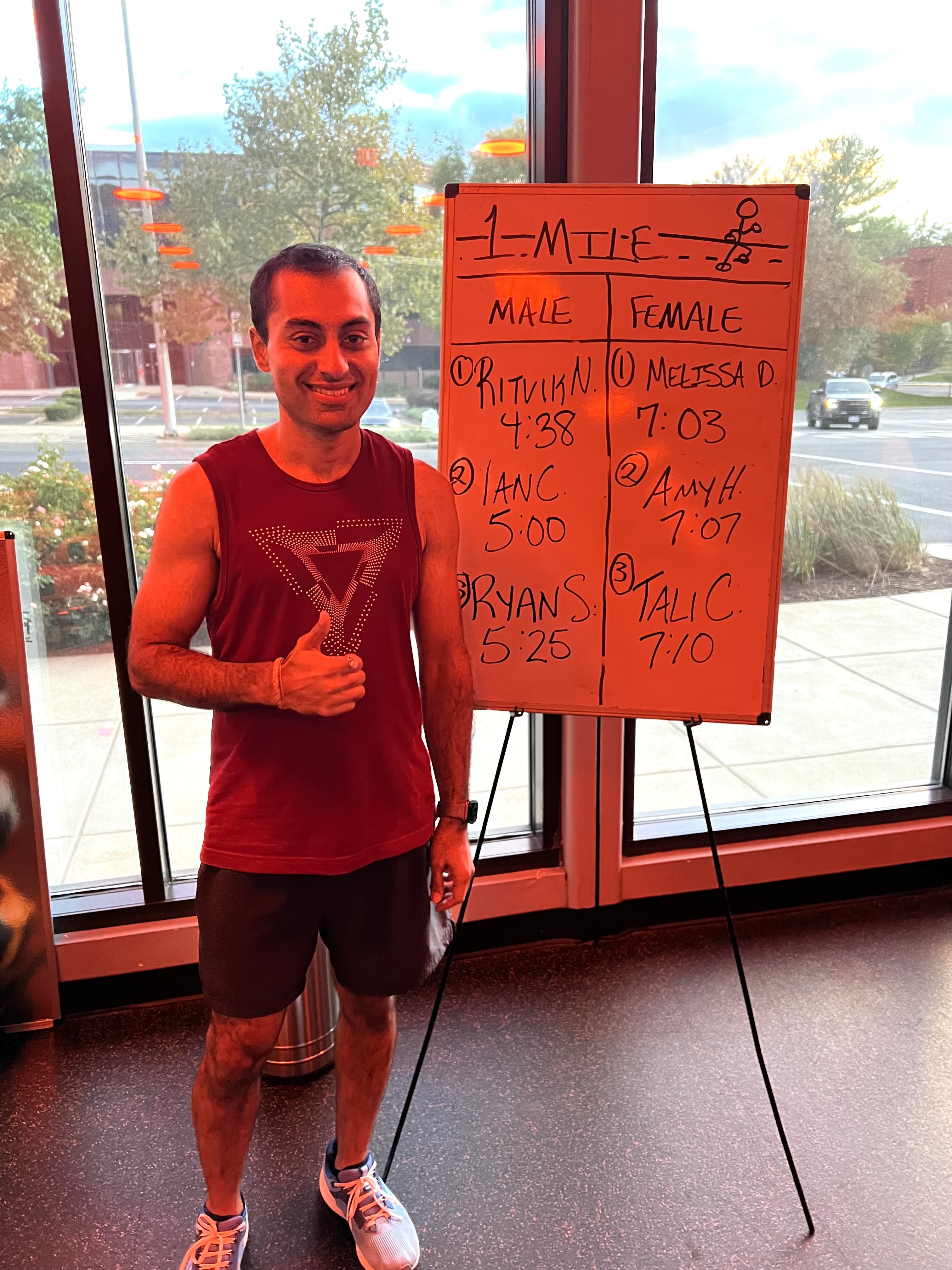
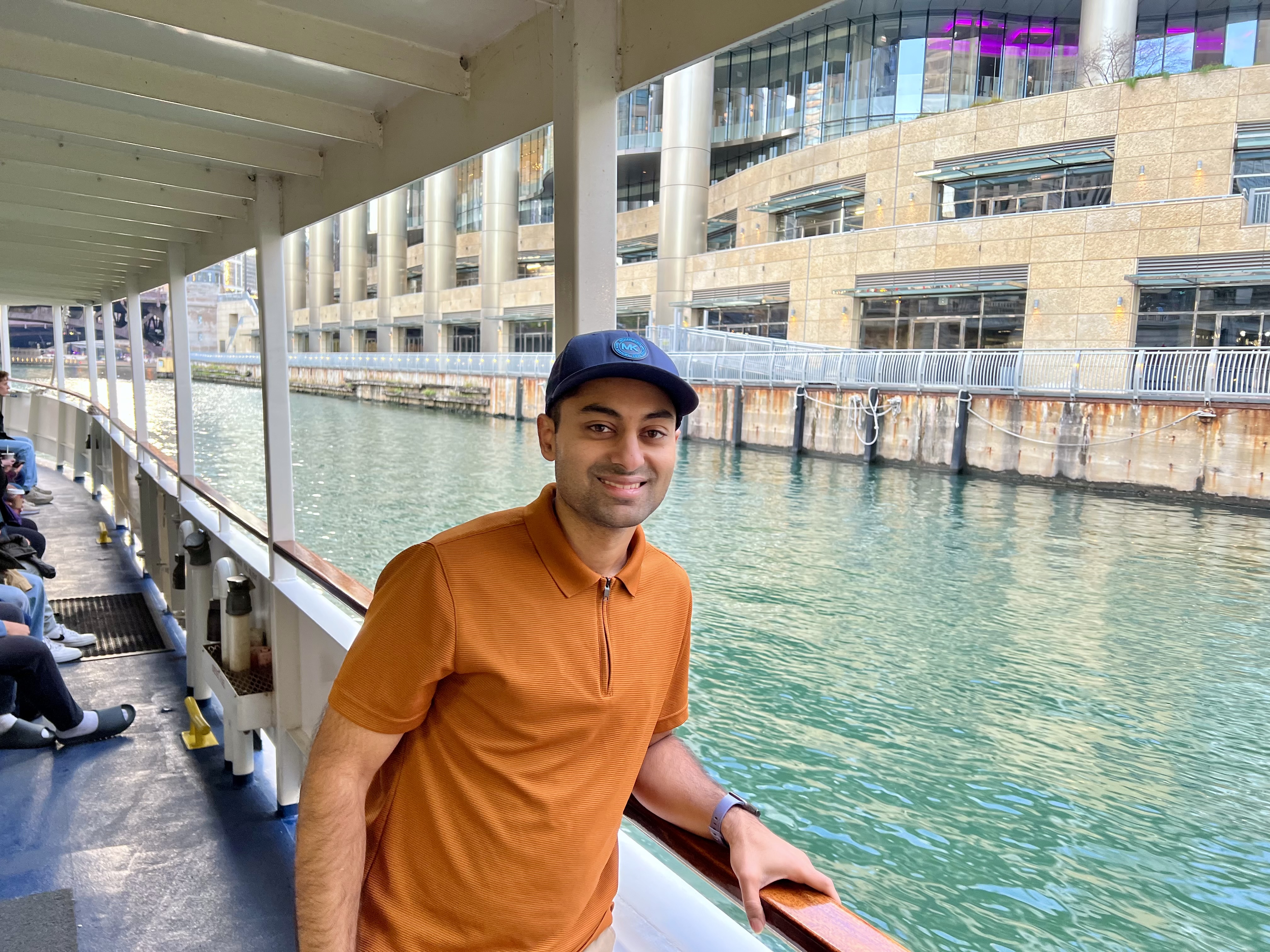
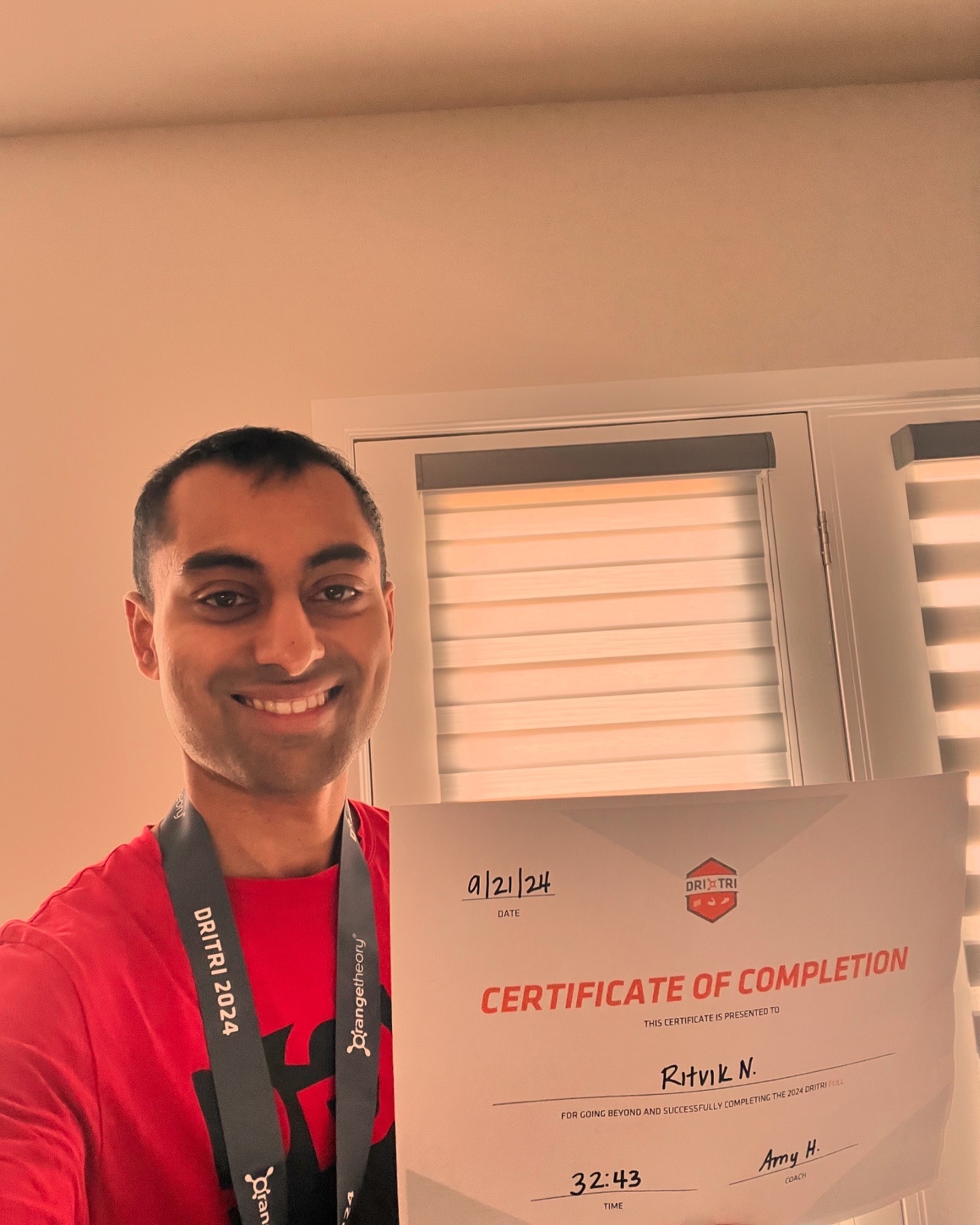
Comments